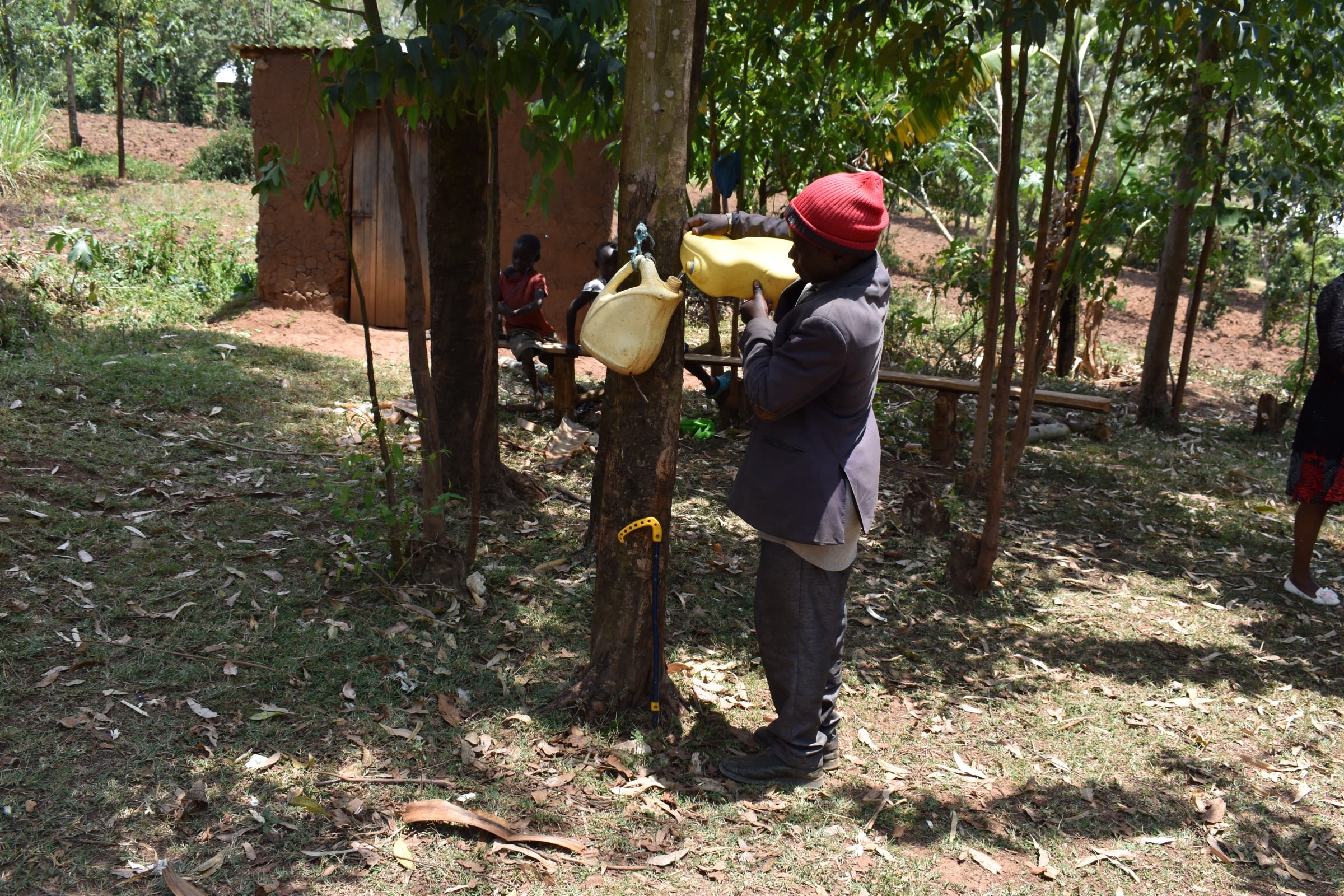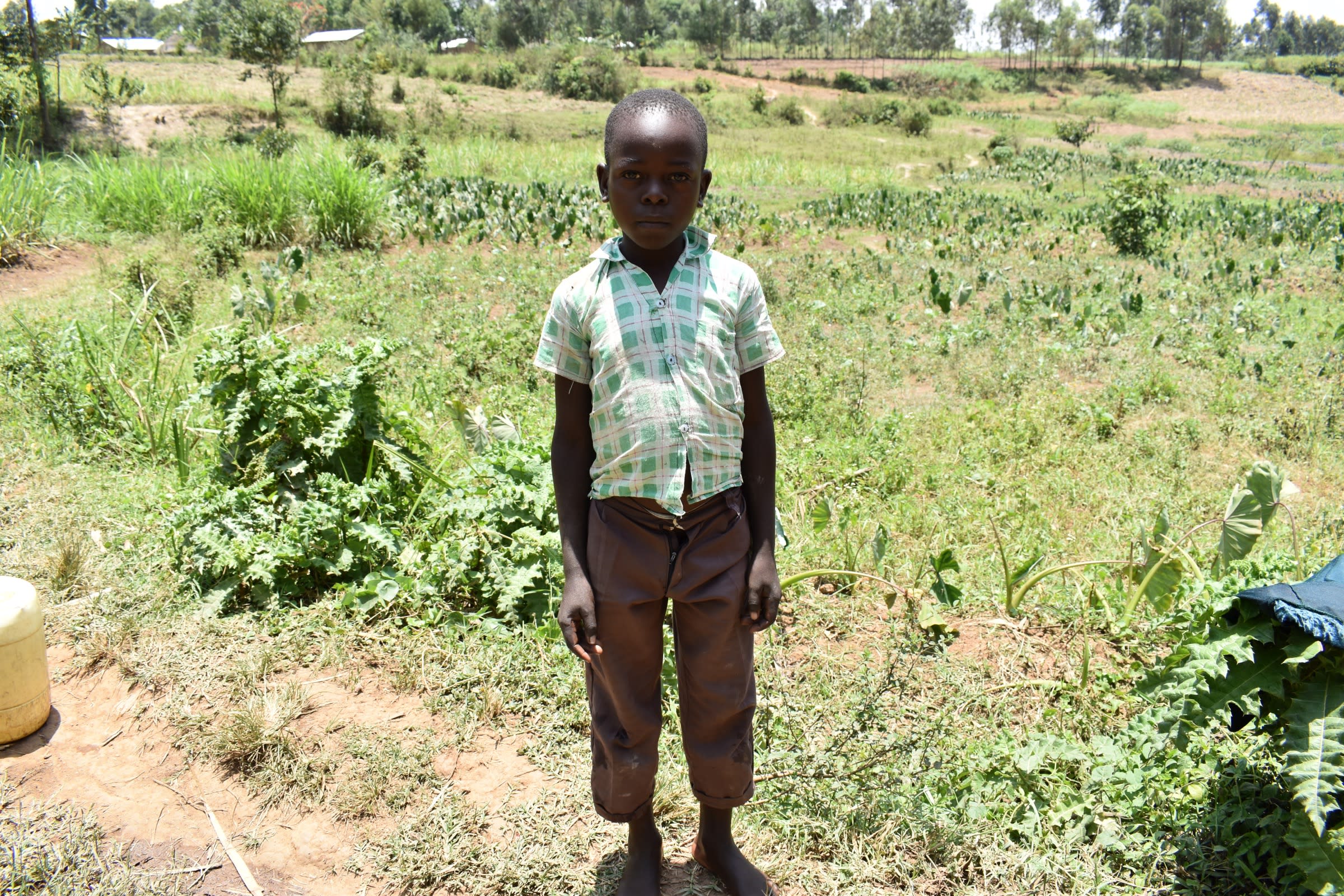The members of Lunyinya community have been fighting typhoid and diarrhea for as far back as anyone can remember. The cause is drinking contaminated water from the open spring. Decades ago, the spring was protected, but it has since fallen into disrepair. Now, the water that comes from the discharge pipe makes everyone who drinks it sick.
Josphat Cheroti, who owns the land the spring is on and is therefore its namesake, explained the cost of drinking dirty water for him. He's in the below picture filling the handwashing station near his home. "Accessing clean water has been a major challenge, and most of the time, I have been forced to visit the hospital for some medication. The medication is expensive."

Sickness, for a farmer like Josphat, also makes it hard to earn a living. All Josphat's daily tasks involve manual labor, which can be painful and tiring to anyone, let alone someone suffering from water-related illness. And he's not the only one whose everyday life is impacted by ingesting contaminated water.
"Consuming water without boiling [it] really affects my health," said 12-year-old Patrick N, in the picture below. "Most times, [I] am forced to be absent in school so I can look for medical attention."

Although contamination is this spring's main problem, it's not the only issue. A huge population accesses this spring every day for water, according to our field officers. This means that many times throughout the day, the spring can become congested with people who must wait in line for hours at a time in order to fill their jerrycans with water. And, once they're the first in line, fetchers must step into the stagnant water beneath the pipe, which is not only inconvenient but dangerous, too.
"Accessing water [at] this source, especially when it rains, is a big challenge," Patrick continued. "[I] am forced to wake up early so that I can fetch water in peace."
With a repaired, protected spring, fetching water here will be a much more pleasant experience for everyone in Lunyinya. Wait times will decrease or disappear altogether, and time will be spent on more productive things than seeking medication.
What We Can Do:
Spring Protection
Protecting the spring will help provide access to cleaner and safer water and reduce the time people have to spend to fetch it. Construction will keep surface runoff and other contaminants out of the water. With the community’s high involvement in the process, there should be a good sense of responsibility and ownership for the new clean water source.
Fetching water is a task predominantly carried out by women and young girls. Protecting the spring and offering training and support will, therefore, help empower the female members of the community by freeing up more of their time and energy to engage and invest in income-generating activities and their education.
Training on Health, Hygiene, COVID-19, and More
To hold trainings during the pandemic, we work closely with both community leaders and the local government to approve small groups to attend training. We ask community leaders to invite a select yet representative group of people to attend training who will then act as ambassadors to the rest of the community to share what they learn. We also communicate our expectations of physical distancing and wearing masks for all who choose to attend.
The training will focus on improved hygiene, health, and sanitation habits in this community. We will also have a dedicated session on COVID-19 symptoms, transmission routes, and prevention best practices.
With the community’s input, we will identify key leverage points where they can alter their practices at the personal, household, and community levels to affect change. This training will help to ensure participants have the knowledge they need about healthy practices and their importance to make the most of their water point as soon as water is flowing.
Our team of facilitators will use a variety of methods to train community members. Some of these methods include participatory hygiene and sanitation transformation, asset-based community development, group discussions, handouts, and demonstrations at the spring.
One of the most important issues we plan to cover is the handling, storage, and treatment of water. Having a clean water source will be extremely helpful, but it is useless if water gets contaminated by the time it is consumed. We and the community strongly believe that all of these components will work together to improve living standards here, which will help to unlock the potential for these community members to live better, healthier lives.
We will then conduct a small series of follow-up trainings before transitioning to our regularly scheduled support visits throughout the year.
Training will result in the formation of a water user committee, elected by their peers, that will oversee the operations and maintenance of the spring. The committee will enforce proper behavior around the spring and delegate tasks that will help preserve the site, such as building a fence and digging proper drainage channels. The fence will keep out destructive animals and unwanted waste, and the drainage will keep the area’s mosquito population at a minimum.

 Protected Spring
Protected Spring
 Rehabilitation Project
Rehabilitation Project










































